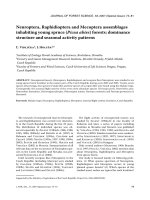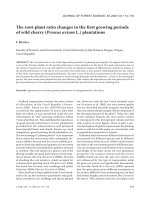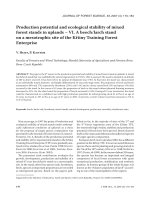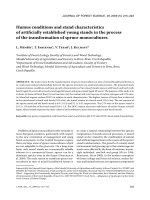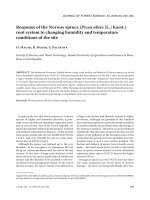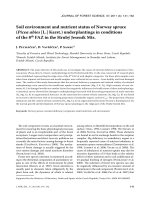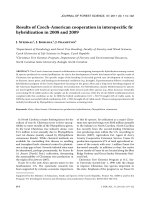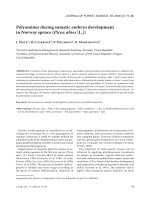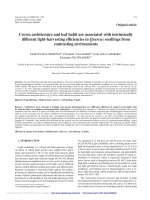Báo cáo lâm nghiệp: "Post-transplant root and shoot development in Abies nordmanniana Spach. seedlings after whorl bud and branch pruning" potx
Bạn đang xem bản rút gọn của tài liệu. Xem và tải ngay bản đầy đủ của tài liệu tại đây (554.89 KB, 5 trang )
Ann. For. Sci. 63 (2006) 843–847 843
c
INRA, EDP Sciences, 2006
DOI: 10.1051/forest:2006067
Original article
Post-transplant root and shoot development in Abies nordmanniana
Spach. seedlings after whorl bud and branch pruning
Lillie A
a
*
, Steen S
b
, Hanne N. R
c
a
Department of Horticulture, Danish Institute of Agricultural Sciences, Kirstinebjergvej 10, 5792 Aarslev, Denmark
b
Poelvej 8, 8340 Malling, Denmark
c
Danish Centre for Forest, Landscape and Planning, Hoersholm Kongevej 11, 2970 Hoersholm, Denmark
(Received 8 March 2006; accepted 7 July 2006)
Abstract – After lifting in a nursery, 3-year-old seedlings of Abies nordmanniana were treated for improvement in new leader growth after transplanting.
The treatments were: (A) whorl (subapical) buds, lateral buds at the stem and whorl branch tips removed; (B) as (A), but with whorl branches removed
at their junction to the stem; and (C) untreated control seedlings. After transplanting in April, plant samples were lifted in June, July and September
to determine the effect of treatments on root and shoot development. Root length and number of root tips were determined by scanning and computed
image analysis. Height, dry weight of shoot and root and ratio between these were determined. Removal of whorl and lateral buds and whorl branch
tips had a negative effect on root and shoot growth after transplanting. Root length, number of root tips and shoot dry weight were reduced, but by
September equaled the untreated control seedlings. Removal of whorl branches caused a significant reduction in both root length and shoot dry weight
compared to untreated control seedlings.
root length / root:shoot / root tip scanning
Résumé – Développement des racines et des pousses après transplantation de semis d’Abies nordmanniana Spach. après une taille des verticilles
de bourgeons et de b ranches. Après arrachage en pépinière, des semis âgés de 3 ans d’Abies nor dmanniana ont été traités pour une amélioration de
la croissance de la pousse après transplantation. Les traitements étaient : (A) verticilles de bourgeons (subapicaux), bourgeons latéraux sur la tige et
apex des verticilles de branches enlevés ; (B) comme (A) mais avec les verticilles enlevés à leur jonction avec le tronc ; et (C) semis témoins non traités.
Après transplantation en avril, des échantillons de plants étaient arrachés en juin, juillet et septembre pour déterminer les effets des traitements sur le
développement des racines et des pousses. La longueur des racines et le nombre des apex étaient déterminés par numérisation et analyse d’images. La
hauteur, le poids sec des pousses et des racines et leur rapport ont été déterminés. L’enlèvement des verticilles et bourgeons latéraux et des verticilles
de branches en apex a eu un effet négatif sur la croissance des racines et des pousses après transplantation. La longueur des racines, le nombre
d’apex racinaires et le poids sec des pousses ont été diminués, mais en septembre ont égalé les semis du traitement témoin non traités. L’enlèvement
des verticilles de branches a causé une réduction significative de la longueur de racines et du poids sec des pousses comparativement aux semis du
traitement témoin non traités.
longueur des r acines / racine/pousse / scanner des pointes racinaires
1. INTRODUCTION
Abies nordmanniana Spach. is grown for Christmas tree
production in Northern Europe, and, after transplanting in the
forest or the field, leader growth is usually very poor in the first
few years after transplanting [2]. New height growth is impor-
tant in reducing the time from planting to final harvest [25].
Leader growth is controlled by environmental factors as light
as in Abies alba [13] or by competition between terminal and
lateral buds as observed in Pinus strobus [28] or both. An ex-
periment aimed at directing more growth into the leader of
seedlings by the removal of buds and branches has shown
promising results [22]. The removal of whorl buds (subapi-
cal buds) in 3-year-old A. nordmanniana seedlings increased
leader growth by up to 30% after transplanting, probably by
removing competition to the apical bud [22]. The removal of
* Corresponding author:
a larger part, such as whorl branches reduced shoot growth af-
ter transplantning in A. nordmanniana [23]. The question is
whether root growth will be reduced by the bud and branch
treatment, as has been shown in Abies balsamea [15]. New
roots are sinks for photosynthetic products in conifers, such
as in Picea sitchiensis and Pseudotsuga menziesii [26]. Re-
ductions in future photosynthetic areas by debudding before
budburst could therefore affect new root growth. At the same
time, however, debudding will increase the root to shoot ratio,
which can be important for the survival and growth of trans-
planted A. nordmanniana seedlings on dry soil conditions and
under competition from weeds [2].
In the present project we focused on the development in
root length and in the number of root tips in a study on root
growth after transplanting A. nordmanniana seedlings. Root
fibrosity is regarded as an indicator of root growth poten-
tial [3,12]. Knowledge concerning development in root growth
Article published by EDP Sciences and available at or />844 L. Andersen et al.
Table I. Monthly mean air and soil temperature (10 cm below ground), sum of precipitation and evapotranspiration [18] at a climatic station
approximately 15 km from the experimental area (DMI).
Air temperature Soil temperature Precipitation Evapotranspiration
(
◦
C) (mm)
May 10.7 11.1 39 80
June 12.5 13.7 88 89
July 17.2 17.8 31 117
August 16.5 17.6 52 80
September 12.1 14.3 93 36
Sum 303 402
development can be used to advantage in improving the suc-
cess rate of transplanting also other conifer species in the for-
est. Root growth studies are laborious and time consuming and
are few in number, but a new procedure in which root length
and number of root tips are determined by scanning renders
determination of these parameters easier. The method has been
used with success in other experiments [7, 10, 11, 14].
As part of a project to stimulate new leader growth the aim
was to study root and shoot development of A. nordmanni-
ana seedlings after transplanting, when whorl and lateral buds
and whorl branch tips or whorl branches had been removed
prior to transplanting, and to compare with untreated control
seedlings.
2. MATERIALS AND METHODS
Three-year-old bare-rooted seedlings (3+0) of A. nordmanniana
from the Ambrolauri provenance were lifted in April 2001 at a Danish
nursery. They had been grown in rows and were root wrenched 20 cm
below ground 5 weeks before lifting. After lifting, the seedlings were
treated as follows: (A) whorl (subapical) buds, lateral buds at the
stem and whorl branch tips were removed by hand; (B) as A, but
with whorl branches removed by scissors at the junction to the stem;
and (C) untreated control seedlings. After treatment samples of 10
seedlings from each treatment were taken for analysis. On average,
5% ± 0.5 of shoot dry weight was removed in treatment (A) and
20% ± 1.8 in treatment (B) compared to the shoot dry weight of con-
trol seedlings.
On the day after lifting and treatment, 50 seedlings in each treat-
ment were transplanted, along with seedlings in other treatments not
referred to here, as part of a private owners Christmastree production
in the open field on a sandy loam soil (app. 10% clay; 65–70% sand)
in Denmark (56
◦
18’ N, 10
◦
08’ E) and were neither irrigated nor fer-
tilised. Before transplanting weeds were controlled by spraying with
herbicides (Diurone 800 g ha
−1
and terbuthylazine 2 kg ha
−1
). Each
individual seedling represented an experimental unit in a fully ran-
domized design. Climatic conditions during the growing period were
analysed from data recorded at a climate station (Danish Meteoro-
logical Institute (DMI)) approximately 15 km from the experimental
field (Tab. I). Evapotranspiration was calculated from global radia-
tion [18].
Plant samples were lifted by hand and pitch fork three times dur-
ing the first growing season: on 20 June, 25 July and 27 September in
2001. Ten seedlings were lifted in each treatment on each occasion;
thus, a total of 90 seedlings were lifted. Although lifting was done
carefully, some fine roots were lost during the process – estimated at
less than 2%, because the sandy conditions allowed the roots to slip
free easily. After lifting, the seedlings were wrapped in wet paper,
put in plastic bags and taken to the laboratory, where they were kept
overnight at 2
◦
C. The roots of each seedling were gently washed be-
fore the shoot and roots were separated at the root collar scar. Roots
were kept in 70% alcohol, separated into bottles and placed at 2
◦
C
until scanning. Before scanning, the roots were washed in cold water
to remove the ethanol.
Root length and number of root tips were determined on a flatbed
scanner (Hewlett-Parkard Scan Jet 4c modified by Regent, Canada)
with Winrhizo
software (WinRHIZO 2002a, Regent, Canada). All
the lateral roots were cut from the taproot and spread on plates
(20 × 30 cm) with 200 mL of de-ionized water, care being taken to
avoid overlapping. Root systems were spread over up to 8 trays to
keep the roots separated from each other. Preliminary studies of A.
nordmanniana root systems in our laboratory had shown that the ac-
curacy of determinations is increased if taproot and lateral roots are
scanned separately and that a resolution at 300 dpi with black and
white background and threshold automatically gives the best correla-
tion to manual determination of root length [7]. Height was measured
from root collar scar to end-bud. Dry weight (DW) of shoot and root
was determined after 48 h of drying at 70
◦
C.
The dataset was analyzed using a general linear model (GLM
SAS
Inc. Cary, NC, USA). Treatments were treated as fixed effects.
The Student-Newman-Keuls test was used for evaluating treatment
effects and probability values of p < 0.05 were considered signif-
icant. Residuals were tested for normality with Univariate analyses
(SAS
Inc. Cary, NC, USA). Standard error (±) was also used.
3. RESULTS
3.1. Root length and root tips
Total root length, including length of both tap and lat-
eral roots, doubled from time of transplanting in April to
first sampling in June in untreated controls and in seedlings
in which whorl and lateral buds and whorl branch tips had
been removed, now significantly greater than where the whorl
branches had been removed (p = 0.0619) (Fig. 1a). In July,
3 months after transplanting, the root length of untreated con-
trol seedlings had increased by a factor of 5 compared to length
at transplanting. Only a small increase in root length was found
Root development after foliar removal 845
Figure 1. (a) Root length (m per plant) from transplanting to Septem-
ber in relation to treatment at transplanting. (b) Number of root tips
(no per plant) from transplanting to September in relation to treat-
ment at transplanting: Whorl and lateral buds and whorl branch tips
removed A (), whorl and lateral buds and whorl branches removed
B() and untreated control plants C (). Significant difference ac-
cording to the Student-Newman-Keuls test (p < 0.05) is indicated by
different letters.
from June to July between the two treatments, now signifi-
cantly shorter than untreated control seedlings (p = 0.0054)
(Fig. 1a). From July to September, however, root length in-
creased in both treatments, while root length in untreated
control seedlings did not change. In September, root length
was not significantly different between untreated control and
seedlings where the whorl and lateral buds and whorl branch
tips had been removed, but was significantly lower in cases
where the whorl branches had been removed in addition (p =
0.1191) (Fig. 1a).
At transplanting the number of root tips was 433 ± 18 as
a mean of all treatments, and from transplanting until the
first sampling in June this increased in all three treatments
(Fig. 1b). In July, the number of root tips was significantly
greater in untreated control than in the treatment where whorl
and lateral buds and whorl branches had been removed (p =
0.0172), but by September the number was not significantly
different between the two treatments and untreated control
(p = 0.6243).
3.2. Height and dry weight
Seedling height increased from time of transplanting up un-
til September, when a not-significant difference between the
treatments was observed (p = 0.6830). Height increment was
17% ± 1.2 where whorl and lateral buds and whorl branches
had been removed and 12% ± 1.4 where whorl and lateral
buds and whorl branch tips had been removed compared to
11% ± 1.5 in untreated control seedlings (data not shown).
Figure 2. (a) Root DW, (b) shoot DW and (c) ratio between root
and shoot from transplanting to September in relation to treatment at
transplanting: Whorl and lateral buds and whorl branch tips removed
A(), whorl and lateral buds and whorl branches removed B ()and
untreated control plants C (). Significant difference according to the
Student-Newman-Keuls test (p < 0.05) is indicated by different let-
ters.
The development in root DW remained low in the period
from transplanting to the first sampling in June (Fig. 2a).
From June to July an increase was observed in the treat-
ment where whorl and lateral buds and whorl branch tips had
been removed, significantly different to the other treatment
(p = 0.0212), but not to untreated controls. A relatively large
increase in root DW was found from July to September in
all treatments, with root DW significantly greater in untreated
controls than in seedlings in which whorl branches had been
removed (p = 0.001) (Fig. 2a). The increase in root DW from
transplanting until September was 229% in untreated controls,
147% in seedlings in which whorl and lateral buds and whorl
branch tips had been removed and 79% where whorl and lat-
eral buds and whorl branches had been removed.
From transplanting until July, a large increase (338%) in
shoot DW was observed in untreated control seedlings as the
new shoots and buds developed, but there was no development
thereafter (Fig. 2b). In the treatment in which whorl and lateral
buds and whorl branch tips had been removed, a near constant
increase in shoot DW was found during the growing season
until September and shoot DW ended up not significantly dif-
ferent from that of the untreated control seedlings. Removal
of whorl and lateral buds and whorl branches reduced shoot
846 L. Andersen et al.
DW, which was significantly less than that of the untreated
control seedlings throughout the growing season (p = 0.0019)
(Fig. 2b).
A drop in root and shoot ratio was observed in all treatments
during the two summer samplings in June and July (Fig. 2c).
However, at the final sampling in September, root:shoot was
improved in all treatments compared to July and not signifi-
cantly different between the two treatments and the untreated
controls (p = 0.5201) (Fig. 2c).
Evapotranspiration was higher than precipitation in the pe-
riod from transplanting until September at the climate station
15 km away from the experimental field (Tab. I). In July the
deficit was large (86 mm), while the total water deficit from
May to the end of September was 99 mm.
4. DISCUSSION
The total height of the seedlings was greater by up to 17%
than the initial height where whorl branches had been removed
and less in the other treatments. Removal of branches could
have caused an increase in the leader growth as observed in
Nothofagus dombeyi [21]. Debudding removes apical inhibi-
tion caused by cytokinin in the whorl buds and branches [16].
However, the increment in height was much less compared to
new leader growth, which was increased by 30% [22]. Hence,
height increment should be further improved to comply with
the costfull operation by debudding. The removal of whorl and
lateral buds and whorl branch tips reduced root and shoot de-
velopment, i.e. root length, root tips and DW in accordance
with results in A. menziesii [15]. However, the root and shoot
development equaled up by September, when root length and
shoot DW were similar to those of the untreated controls
(Figs. 1 and 2b). The sequence in root length suggests that
removal of buds at the same time removed a shoot-to-root sig-
nal, which had to be synthesized before root elongation could
continue [1,5,20]. Conifer buds are high in auxin, which might
be lowered by the debudding proces [1, 6,27]. Removal of the
whorl and lateral buds and whorl branches had a more severe
effect on plant growth and caused a reduction in root length
and DW. Removal of a significant part of the photosynthetic
area was the likely reason for the reduction in root and shoot
growth, which was in accordance with [26], who observed that
current photosynthesis was responsible for new root growth in
conifer species, and with [24], who found similar results in
Pinus taeda L.
No straightforward relation was observed between number
of root tips and root growth after transplanting, which is con-
trary to the findings of others [8,12]. Surprisingly, root length
was improved without root DW being affected at the first sam-
pling in June in both treatments and control (Figs. 1 and 2a).
Later, from July to September, root length in untreated con-
trol seedlings did not increase to the extent that root DW did,
which suggests that carbohydrates accumulated as storage in
the roots after shoot growth had ceased [9]. Hence A. nord-
manniana showed a plasticity in root development as found in
beech but not in Pinus [11].
Shoot DW was affected similarly to root DW in relation
to treatments before transplanting. Removal of whorl and lat-
eral buds and whorl branch tips changed the shoot DW ac-
cumulation probably in parallel with loss of the photosyn-
thetic area in the removed buds [23] (Fig. 2b). At the final
sampling in September, shoot DW had equaled that of the un-
treated control seedlings, which is in accordance with the re-
sults of [22]. Shoot growth fell off in untreated control plants
from July to September, whereas root DW continued to ac-
cumulate (Fig. 2a). Evapotranspiration was high in July com-
pared to precipitation and might have affected the untreated
control seedlings with a lower root:shoot. In addition to ini-
tial root collar diameter [17], root:shoot can be a predicter
of growth after transplanting in many conifer species [2, 19].
However, the change in root:shoot during the growing season
in A. nordmanniana and the possible signalling between root
and shoot should be given more attention in future work [4].
As concluding remarks, the new method to increase leader
growth did not significantly increase height in the present
experiment, and further studies aimed at optimizing leader
growth after transplanting should focus on further height in-
crement and methods to employ in practice.
Acknowledgements: The study was supported by “The Production
Fee Foundation for Christmas Trees and Greenery” grant No. 2000–
0030. We are greateful to two anonymous reviewers for valuable
comments on the manuscript.
REFERENCES
[1] Aldén T., Seasonal variations in the occurrence of indole-3-acetic
acid in buds of Pinus silvestris, Physiol. Plant. 25 (1971) 54–57.
[2] Andersen L., Bentsen N.S., Survival and growth of Abies nordman-
niana in the forest and the field in relation to seedling size and root
pruning prior to transplanting, Ann. For. Sci. 60 (2003) 1–6.
[3] Atzmon N., Reuveni O., Riov J., Lateral root formation in pine
seedlings. II. The role of assimilates, Trees 8 (1994) 273–277.
[4] Bertrand A., Castonguay Y., Plant adaptions to overwintering
stresses and implications of climate change, Can. J. Bot. 81 (2003)
1145–1152.
[5] Beveridge C.A., Long-distance signalling and a mutational analysis
of branching in pea, Plant Growth Regul. 32 (2000) 193–203.
[6] Bollmark M., Chen H J., Moritz T., Eliasson L., Relations between
cytokinin level, bud development and apical control in Norway
spruce, Picea abies, Physiol. Plant. 95 (1995) 563–568.
[7] Bouma T.J., Nielsen K.L., Koutstall B., Sample preparation and
scanning protocol for computerised analysis of root length and di-
ameter, Plant Soil 218 (2000) 185–196.
[8] Burdett A.N., Herring L.J., Thompson C.F., Early growth of planted
spruce, Can. J. For. Res. 14 (1984) 644–651.
[9] Canham C.D., Berkowitz A.R., Kelly V.R., Lovett G.M., Ollinger
S.V., Schnurr J., Biomass allocation and multiple resource limita-
tion in tree seedlings, Can. J. For. Res. 26 (1999) 1521–1530.
[10] Comas L.H., Bouma, T.J., Eissenstat, D.M., Linking root traits to
potential growth rate in six temperate tree species, Oecologia 132
(2002) 34–43.
[11] Curt T., Coll L., Prévosto B., Balander P., Kunstler G., Plasticity in
growth, biomass allocation and root morphology in beech seedlings
as induced by irradiance and herbaceous competition, Ann. For. Sci.
62 (2005) 51–60.
Root development after foliar removal 847
[12] Deans J.D., Lundberg C., Cannell M.G.R., Murray M.B., Sheppard
L.J., Root system fibrosity of Sitka spruce transplants: relationship
with root growth potential, Forestry 63 (1990) 1–7.
[13] Grassi G., Giannini R., Influence of light and competition on crown
and shoot morphological parameters of Norway spruce and silver
fir saplings, Ann. For. Sci. 62 (2005) 269–274.
[14] Krasowski M.J., Owens J.N., Tackaberry L.E., Massicotte H.B.,
Above and below ground growth of white spruce seedlings with
roots divided into different substrates with and without controlled-
release fertilizer, Plant Soil 217 (1999) 131–143.
[15] Lavigne M.B., Little C.H.A., Major J.E., Increasing the sink:source
balance enhances photosynthetic rate of 1-year-old balsam fir fo-
liage by increasing allocation of mineral nutrients, Tree Physiol. 21
(2001) 417–426.
[16] Little C.H.A., Promoting bud development in balsam fir Christmas
trees with 6 benzylaminopurine, Can. J. For. Res. 14 (1984) 447–
451.
[17] Mason E.G., A model of the juvenile growth and survival of Pinus
radiata D. Don, New For. 22 (2001) 133–158.
[18] Mikkelsen H., Olesen J.E., Sammenligning af metoder til bestem-
melse af potentiel vandfordampning, Tidsskr. Planteavls Special se-
rie, S 2157 (1991) 67 p. (in Danish with English summary).
[19] Noland T.L., Mohammed G.H., Wagner R.G., Morphological char-
acteristics associated with tolerance to competition from herba-
ceous vegetation for seedlings of jack pine, black spruce, and white
pine, New For. 21 (2001) 199–215.
[20] Philipson J.J., Coutts M.P., Effects of growth hormone application
on the secondary growth of roots and stems in Picea sitchensis
(Bong.) Carr. Ann. Bot. 46 (1980) 474–755.
[21] Puntieri J.G., Stecconi M., Brion C., Mazzini C., Grosfeld J., Effects
of artificial damage on the branching pattern of Nothofagus dombeyi
(Nothofagaceae), Ann. For. Sci. 63 (2006) 101–110.
[22] Rasmussen H.N., Sørensen S., Andersen L., Lateral buds and shoots
affect leader growth in Abies nor dmanniana Spach., Scand. J. For.
Res. 18 (2003) 127–132.
[23] Rasmussen H.N., Sørensen S., Andersen L., Bud set in Abies nord-
manniana Spach. influenced by bud and branch manipulations,
Trees 17 (2003) 510–514.
[24] Sword M.A., Gravett D.A., Faulkner P.L., Chambers J.L., Seasonal
branch and fine root growth of juvenile loblolly pine five growing
seasons after fertilization, Tree Physiol. 16 (1996) 899–04.
[25] Sæbø A., Can growth be programmed to yield high quality
Christmas trees? In: Christensen C.J. (Ed.), Improvement in
Christmas tree and greenery quality, Proceedings from the inter-
national Christmas tree and greenery research and extension con-
ference 31, July – 3. August, Denmark. Danish Centre for Forest,
Landscape and Planning (2000), Reports 7, 2000, pp. 43–46, ISBN
87-7903-076-9.
[26] Van den Driesche R., Importance of current photosynthate to new
root growth in planted conifer seedlings, Can. J. For. Res. 17 (1987)
776–782.
[27] Wang Q., Little C.H.A., Odén P.C., Control of longitudinal and
cambial growth by gibberellins and indole-3-acetic acid in current-
year shoots of Pinus sylvestris, Tree Physiol. 17 (1997) 715–721.
[28] Wilson F.B., Compensatory growth in shoot populations of young
white pine trees, Trees 6 (1992) 204–209.
To access this journal online:
www.edpsciences.org/forest
